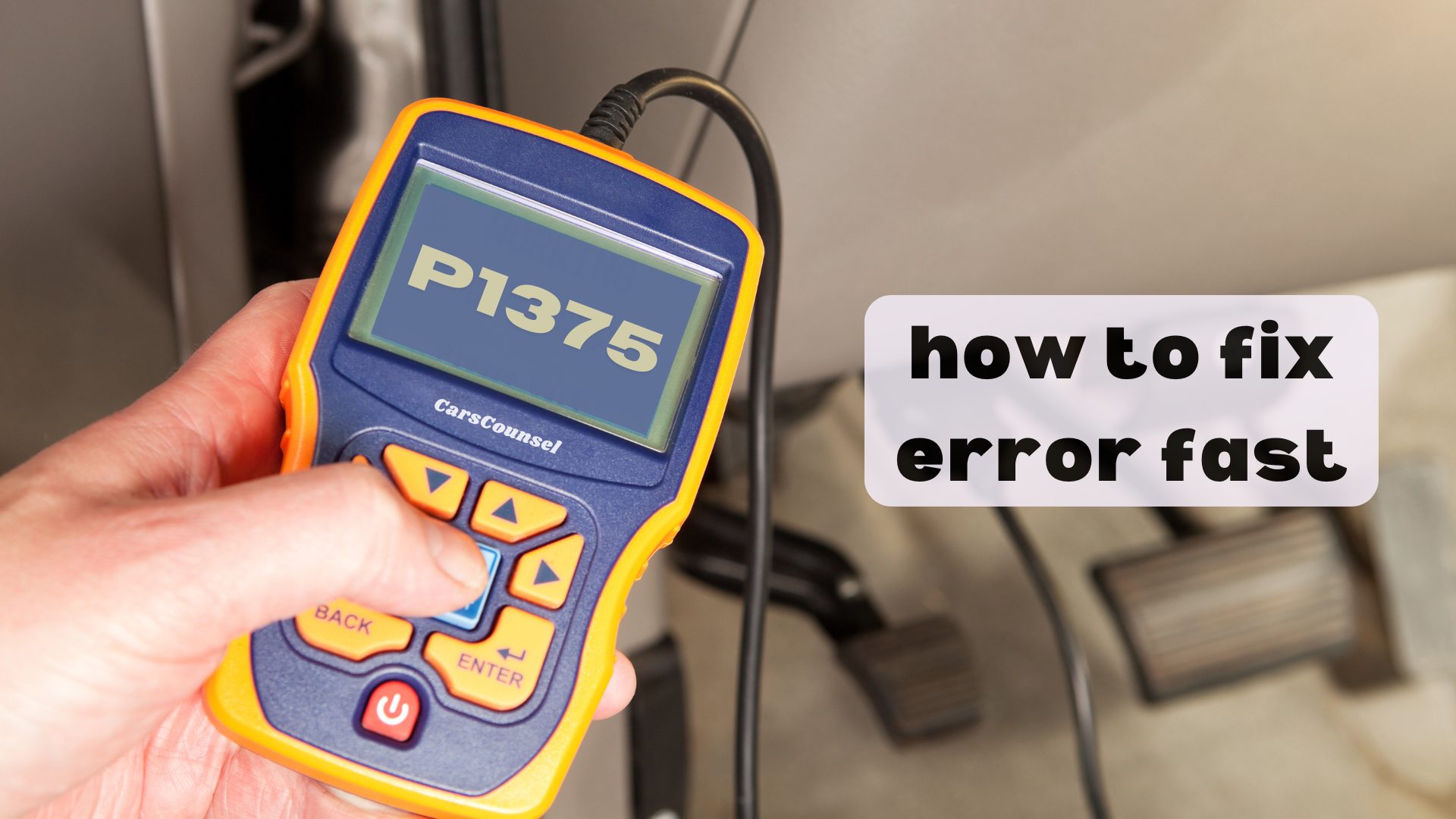You’ve got a P1375 code on your hands, indicating a high voltage issue in the IC 24X Reference Circuit. This critical system provides essential data on crankshaft and camshaft position to your Engine Control Module (ECM), so it’s no wonder you’re experiencing engine misfires, rough idling, and reduced power. But what’s causing the high voltage?
Is it a circuit overload, a faulty component, or an electrical surge? To get your engine running smoothly again, you’ll need to dig deeper and pinpoint the root cause of the problem.

Quick Navigation
Key Takeaways
- High voltage in the IC 24X Reference Circuit can cause engine misfires, rough idling, and reduced power, triggering the P1375 code.
- Circuit overload, faulty components, electrical surges, and wiring issues can cause high voltage readings in the IC 24X Reference Circuit.
- Identifying the underlying cause of high voltage is crucial for accurate diagnosis and repair of the P1375 code issue.
- A faulty voltage regulator, crankshaft, or camshaft sensor can contribute to high voltage in the IC 24X Reference Circuit.
- Thorough circuit testing, sensor verification, and wiring inspection are essential steps in diagnosing and repairing the P1375 code issue.
Code P1375 Description and Function
The P1375 code refers to a specific issue with your vehicle’s IC 24X Reference Circuit, which provides the Engine Control Module (ECM) with pivotal data regarding the crankshaft and camshaft’s position.
This information is essential for the ECM to accurately control the ignition timing and fuel injection processes, ensuring peak engine performance.
The crankshaft functions, including its rotational speed and angular position, are indispensable for the ECM to calculate the correct ignition timing.
Any malfunction in the IC 24X Reference Circuit can disrupt the engine’s crankshaft functions, leading to issues with engine performance, such as misfires, rough idling, and reduced power.
Causes of High Voltage in IC 24X
When diagnosing a P1375 code, identifying the underlying cause of high voltage in the IC 24X Reference Circuit is vital.
You need to determine why the voltage is exceeding the specified range.
High voltage in the IC 24X Reference Circuit can be caused by various factors, including:
- Circuit Overload: When the circuit is subjected to excessive electrical load, it can lead to a voltage spike, causing the high voltage reading.
- Voltage Spike: A sudden and brief increase in voltage can also cause the high voltage reading in the IC 24X Reference Circuit.
- Faulty components: A malfunctioning voltage regulator or other components in the circuit can also cause high voltage readings, making it essential.
Symptoms of a Faulty IC 24X Circuit
Identifying the symptoms of a faulty IC 24X circuit is key to diagnosing a P1375 code.
If you’re experiencing issues with your vehicle’s engine performance, it could be related to a malfunctioning IC 24X circuit. You may notice engine misfires, rough idling, or stalling, which can lead to reduced engine power and poor fuel economy.
Ignition issues are also common, as the faulty circuit can disrupt the ignition timing and fuel injection processes. Additionally, the Check Engine Light may illuminate, indicating a problem with the engine control system.
Diagnosing the P1375 Code Issue
Since you’ve retrieved the P1375 code using a scan tool, it’s time to plunge further into diagnosing the issue.
Now, you need to analyze the circuit diagram to identify any potential faults in the IC 24X Reference Circuit. This will help you pinpoint the exact location of the problem, making it easier to repair.
- Check the wiring and connectors for any signs of damage or corrosion.
- Use the scan tool to monitor the circuit’s voltage and compare it to the specified range.
- Consult the factory service manual for detailed circuit diagrams and troubleshooting guides to verify accurate diagnosis.
Repairing the IC 24X Reference Circuit
Frequently, repairing the IC 24X Reference Circuit requires a meticulous approach to guarantee the issue is resolved accurately and efficiently.
You’ll need to perform thorough circuit testing to identify the root cause of the high voltage problem. This involves using electrical troubleshooting techniques to inspect the wiring and connectors for signs of damage or corrosion.
Check the voltage regulator’s functionality and replace it if necessary. Verify the crankshaft and camshaft position sensors are operating correctly, and replace any faulty sensors.
Once you’ve addressed the underlying issue, clear the DTC and perform a test drive to confirm the repair. By following these steps, you’ll be able to resolve the P1375 code and restore proper engine performance.
Checking Crankshaft and Camshaft Sensors
Accuracy is crucial when checking crankshaft and camshaft sensors, as faulty readings can lead to misdiagnosis and prolonged repair times.
You’ll need to perform sensor testing to identify any issues with the sensors. During circuit analysis, pay close attention to the voltage readings and compare them to the specified range.
- Verify the sensor’s electrical connection and guarantee it’s clean and free of corrosion.
- Use a multimeter to measure the sensor’s output voltage and compare it to the manufacturer’s specifications.
- Consult the repair manual for specific troubleshooting procedures and voltage ranges for your vehicle’s make and model.
Wiring and Connector Inspection
Reliability hinges on a thorough examination of the wiring and connectors in the IC 24X Reference Circuit, as a single faulty connection can lead to a P1375 code.
You’ll need to inspect the wiring for signs of damage, such as cracks, frays, or burn marks. A corrosion check is also vital, as corrosion can cause resistance in the circuit, leading to voltage fluctuations.
You should also verify that all connectors are securely fastened and not loose. Wire damage can cause a voltage drop, which may trigger the P1375 code. Look for any signs of overheating, such as melted insulation or discoloration.
A meticulous inspection will help you identify any issues and guarantee a reliable repair.
Voltage Regulator Malfunction Symptoms
Inspect the voltage regulator for signs of malfunction, as a faulty regulator can cause the IC 24X Reference Circuit voltage to exceed the specified range, triggering the P1375 code.
A malfunctioning voltage regulator can lead to voltage fluctuations, electrical surges, and other issues that affect the performance of your vehicle.
When the voltage regulator fails, you may notice:
- Unstable engine idling or stalling
- Reduced engine power and performance
- Illuminated Check Engine Light
These symptoms can be indicative of a voltage regulator malfunction, which can cause the IC 24X Reference Circuit voltage to fluctuate, resulting in the P1375 code.
It’s essential to diagnose and address the issue promptly to prevent further damage to your vehicle’s engine and electrical systems.
Clearing the P1375 Code and Test Drive
After diagnosing and repairing the underlying cause of the P1375 code, it’s essential to clear the code and perform a test drive to guarantee the issue has been resolved.
Clear the error code using a scan tool, following the manufacturer’s guidelines.
Next, perform a test drive to verify the repair. During the test drive, pay attention to the engine’s performance, monitoring for any signs of misfires, rough idling, or stalling.
Follow road test protocols, such as driving on various road types, including highways and city streets, to simulate real-world conditions.
Take note of any unusual noises, vibrations, or performance issues. These test drive tips will help you certify the P1375 code has been properly cleared and the issue is fully confirmed.
Repair Cost and Additional Resources
In terms of repairing a P1375 code, the cost can vary widely depending on the specific cause of the issue, the labor rates in your area, and the extent of the repairs required.
You’ll need to get a repair estimate from a professional mechanic who can assess the issue and provide a detailed quote.
- Consult factory service manuals for specific repair guidance
- Utilize diagnostic tools to identify the root cause of the issue
- Research local labor rates to get an accurate estimate of repair costs
More OBD-II Codes
Frequently Asked Questions
Can a Faulty Oxygen Sensor Trigger a P1375 Code?
You won’t typically see a faulty oxygen sensor trigger a P1375 code, as it’s unrelated to the IC 24X Reference Circuit; however, sensor failure symptoms like rich or lean engine conditions might indirectly affect crankshaft and camshaft position sensor accuracy, requiring O2 sensor replacement.
Will a P1375 Code Cause My Vehicle to Stall While Driving?
When driving, you may experience stalling due to poor engine performance, which can be triggered by issues affecting your vehicle’s reliability, such as faulty sensors or circuit malfunctions, ultimately leading to a loss of power and stalling.
Does a P1375 Code Always Illuminate the Check Engine Light?
You’ll typically see the Check Engine Light illuminated when your vehicle’s engine computer detects abnormal voltage readings, affecting engine performance.
Can I Drive My Vehicle With a P1375 Code Safely?
You’re wondering if you can drive your vehicle safely with a P1375 code; however, it’s not recommended as it can cause engine misfires, rough idling, and reduced power, compromising vehicle safety and roadworthiness, so it’s best to address the issue promptly.
Will a P1375 Code Affect My Vehicle’s Overall Fuel Efficiency?
You’ll likely notice a decrease in fuel efficiency due to the P1375 code, as the faulty IC 24X Reference Circuit affects engine performance, causing the fuel injector to malfunction and reducing overall engine efficiency, leading to poor gas mileage.
Conclusion
You’ve now grasped the importance of resolving the P1375 code issue in your vehicle’s IC 24X Reference Circuit. Did you know that according to the Automotive Research Association of India, approximately 70% of engine-related problems are caused by electrical system failures? This statistic underscores the critical role of accurate diagnosis and repair to prevent further damage and costly repairs. By following the steps outlined above, you’ll be well on your way to restoring your engine’s performance and avoiding potential pitfalls.

